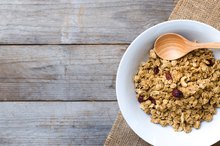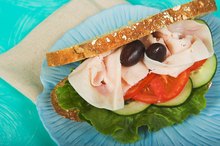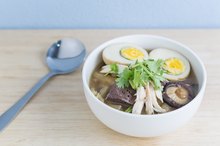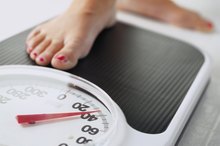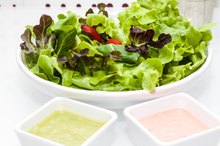How to Lose 90 Pounds Quickly
If you’re obese, losing 90 pounds quickly can help you feel better and reduce your risk for developing obesity-related diseases, such as heart disease and diabetes. According to the Academy of Nutrition and Dietetics, a safe rate of weight loss is one to two pounds per week, which means it may take you at least 45 weeks to lose 90 pounds. Weight Control Information Network reports that you can lose up to five pounds per week by consuming a very low-calorie diet consisting of 800 calories or less per day; however, this type of rapid weight loss program is only recommended under medical supervision, and may cause unpleasant and sometimes dangerous side effects.
Plan Your Meals and Workouts
Choose an energy intake of 1,000, 1,200, 1,400 or 1,600 calories per day, depending on your gender and activity level. According to the U.S. Department of Health and Human Services, most women can lose weight safely and effectively by consuming 1,000 to 1,200 calories per day, while most men, active women and women who weigh 165 pounds or more usually require 1,200 to 1,600 calories per day for weight loss. If you feel hungry while on your plan, choose a slightly higher energy intake.
400 Calorie Meal Ideas
Learn More
Pick a meal plan that fits your calorie needs by using the U.S. Department of Agriculture’s Dietary Guidelines for Americans 2010. For example, a USDA 1,200-calorie meal plan contains 3 ounces of protein foods, 2.5 cups of dairy products, 4 ounces of grains, 1.5 cups of vegetables, 1 cup of fruit, 4 teaspoons of oils and 121 extra calories. For questions regarding portion sizes of foods in each group, use ChooseMyPlate.gov.
Create weight loss menus using your USDA meal plan. For example, a 1,200-calorie weight loss menu may include: breakfast: one large scrambled egg, two slices of whole grain toast topped with 2 teaspoons of soft, tub margarine, one-half cup of low-fat cottage cheese and one large orange; morning snack: 1 cup of plain, low fat yogurt; lunch: 2 ounces of canned light tuna, 1 teaspoon of mayonnaise, six low-sodium, whole grain crackers and one-half cup of raw carrots; afternoon snack: one low-sodium, mozzarella cheese stick; and dinner: 2 ounces of grilled chicken, three-fourths cup of brown rice, 1 cup of streamed broccoli and 1 teaspoon of olive oil.
How to Use Lean Cuisine in Place of NutriSystem
Learn More
Use the USDA’s Food Tracker to keep an online food diary and make sure you stick to your daily calorie goals. You can determine the calorie, carbohydrate, protein, fat and sodium content of each meal in Food Tracker by clicking on the “Nutrients Reports” link under the “My Reports” tab. A nutrient report for the 1,200-calorie weight loss menu listed above shows that it contains 1,215 total calories, 122 grams of carbohydrates, 90 grams of protein, 43 grams of fat and 2,246 milligrams of sodium. The U.S. Department of Agriculture recommends limiting sodium to less than 2,300 milligrams per day to reduce your risk for high blood pressure and heart disease.
Exercise at least 30 minutes most days of the week to help accelerate weight loss, improve your muscle-to-fat ratio and keep lost weight off long-term. Mayo Clinic reports that while calorie control is most beneficial for weight loss, exercise can also help you lose weight and keep it off. Incorporate cardiovascular exercises, such as walking, jogging, biking or swimming and resistance training exercises, such as weight lifting, squats, lunges, pushups and situps, into your program.
Related Articles
References
- Academy of Nutrition and Dietetics: American Dietetic Association Publishes Evidence-based Nutrition Practice Guidelines for Registered Dietitians
- Weight Control Information Network: Very-Low-Calorie Diets
- U.S. Department of Health and Human Services: Aim for a Healthy Weight
- U.S. Department of Agriculture; U.S. Department of Health and Human Services: Dietary Guidelines for Americans 2010
Resources
Writer Bio
Erin Coleman is a registered and licensed dietitian. She also holds a Bachelor of Science in dietetics and has extensive experience working as a health writer and health educator. Her articles are published on various health, nutrition and fitness websites.
